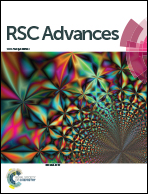NHC catalysed direct addition of HMF to diazo compounds: synthesis of acyl hydrazones with antitumor activity†
Abstract
NHC umpolung catalysis between 5-hydroxymethyl furfural (HMF) derivatives and diazo compounds overcomes the usual multistep synthesis of acylhydrazones and gives direct access to an unexplored family of HMF-based acylhydrazones displaying promising anti-tumor activity. A preliminary screening of hydroxymethyl's protection groups allowed the identification of the tert-butyldimethylsilyl group as being essential for the desired biological activity. Compound 25 was found to be very active against MCF-7 breast cell line (with an IC50s of 3.60 μM) and while exerting a much lower toxicity in differentiated CaCo-2 monolayer.


 Please wait while we load your content...
Please wait while we load your content...